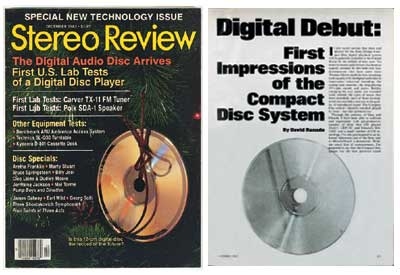The CD: 16 Bits and 20 Years Page 2
• Semiconductor lasers. The CD wasn't the first consumer product containing a laser - that honor belongs to the laserdisc system, which used gas-filled helium-neon laser tubes. But CD players were the first products to exploit the then ultra-high-tech solid-state semiconductor laser. (The lasers were so high-tech that it was said CD players had export restrictions to prevent the lasers from "falling into the wrong hands.") Emitting an invisible near-infrared beam, the new lasers consumed far less power than gas lasers, were much more compact, immune to physical abuse and misalignment, and lasted far longer (the laser in my 20-year-old CDP-101 still works, even if little else in the player does). Without solid-state lasers, portable CD players and CD boomboxes would be impractical. Red-beam semiconductor lasers are now at the heart of the DVD system and its portable players, and devices emitting even shorter-wavelength blue beams are the core technology for the upcoming high-definition DVD systems. 
• Linear PCM audio data encoding. The CD format, of course, was the first to employ digital audio and its mathematical framework, which includes such things as the absolutely fundamental "sampling theorem." There was a lot of debate as to how digital audio should be encoded - essentially, the type of number to be recorded. In the end, the most computer-friendly format was selected: linear pulse-code modulation (PCM), in which the voltage of an analog signal is divided into evenly spaced ("linear") steps, each of which is assigned a binary number (the "pulse code"). The CD pulse code is composed of 16 binary bits, allowing 216 data steps and decimal-equivalent numbers running from -32,768 to +32,767.
Developments in the following decades have shown the wisdom of choosing linear PCM. It greatly simplifies any digital signal processing (DSP) that must be performed on the audio. For example, the digital equalizers and ambience-enhancement systems now found in advanced A/V receivers all manipulate audio in PCM form. DVD-Audio also uses PCM, but with a maximum of 24 bits of resolution (224 data steps running from -8,388,608 to +8,388,607). Single-bit encoding systems, such as the Direct Stream Digital data format employed for Super Audio CDs, do not have an easy affinity for traditional DSP, a factor that has hampered the development of such things as bass management and speaker-distance compensation in SACD players.
• A 12-centimeter polycarbonate disc substrate. Philips initially proposed that the CD be a smaller disc with maybe 45 minutes playing time. But legend has it that the late Akio Morita, then head of Sony, marched into its R&D department one day and "requested" that the new system be able to hold a complete performance of Beethoven's Ninth Symphony, which usually runs more than an hour and is extremely popular in Japan. The disc was widened to 12 centimeters (about 4 3/4 inches) so that it could hold a maximum of 74 minutes, a limit later slightly extended by improvements in disc mastering. The disc size has proved to be convenient for most CD applications, has imposed itself on the DVD and SACD, and will apparently survive into the high-def DVD format(s).
Polycarbonate is still used as the substrate material. Previously it had been employed as a type of bulletproof "glass" and in airliner windows. It's tougher than the plastic in laserdiscs and much less sensitive to environmental factors like humidity. All of my discs of 20 years ago still play, even the ones I had boiled as part of an experiment to see if I could destroy them!
• Reed-Solomon digital error correction. The CD format was the first consumer product to exploit the specialized mathematical area of digital error correction, which had been used in such applications as communications with space probes. In addition to the PCM audio, the system records "redundant" data, mathematically derived from the audio, that are used in playback to identify and correct errors that arise from disc defects and damage. Without error correction, CD playback would be filled with clicks and pops, and it would be very sensitive to scratches and fingerprints. The same type of error correction is still hard at work in the DVD system.




























































